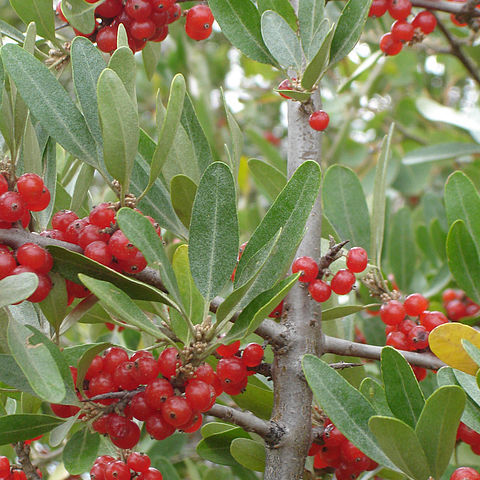Trees or shrubs, deciduous or evergreen; most parts with distinctive silvery or brownish peltate scales and/or stellate hairs, sometimes branches spine-tipped. Leaves alternate, opposite, or whorled; stipules absent; petiole usually present, sometimes short; leaf blade often leathery, simple, margin entire or subentire, abaxially densely stellate-hairy or peltate-scaly, pinnately veined. Flowers solitary or in clusters or short racemes, actinomorphic, bisexual, or unisexual (plants dioecious). Calyx in bisexual and female flowers tubular, 2-6(-8)-lobed, male flowers of Hippophaë of 2 membranous sepals. Petals absent. Stamens 4-8, free, adnate to calyx tube, in male flowers 2 × as many as the lobes, in bisexual flowers as many as the lobes and alternate with them. Ovary superior but tightly enclosed in differentiated basal part of calyx and apparently inferior, 1-loculed; style elongate, stigma lateral. Ovule 1, basal, anatropous. Fruit drupelike, indehiscent, enclosed in base of calyx tube and containing a single seed.
More
Shrubs, woody climbers or (not in Australia) trees, often thorny, densely covered with peltate scales or stellate hairs. Leaves alternate or (not in Australia) opposite, simple, entire, pinnately veined, exstipulate. Flowers axillary, solitary or in umbels, fascicles or cymes, actinomorphic, unisexual or bisexual, strongly perigynous. Perianth 1-whorled, 2-or 4-lobed, rarely 5-8-lobed; lobes valvate, often petaloid; hypanthium tubular, commonly constricted just above ovary. Stamens inserted in throat of hypanthium, as many as and alternate with perianth lobes or twice as many as and both alternate with and opposite to them; anthers 2-locular, dehiscing longitudinally. Nectary disc commonly present on inner surface of hypanthium, lobed. Ovary superior, unilocular; placentation basal; ovule 1, anatropous; style elongate, slender; stigma linear to capitate. Fruit drupe-like or berry-like; consisting of a dry achene that is enveloped by the persistent mealy or fleshy base of hypanthium; endosperm scanty or none.
A number of species (including variegated-leafed and hybrid cultivars) are grown as ornamental (often as hedge and border plants), deciduous or evergreen shrubs or small trees, e.g. Elaeagnus angustifolia L. (Oleaster, Russian Olive), E. latifolia L. (Bastard Oleaster, Himalayan Silverbush), E. macrophylla Thunb. (Russian Olive, Silverberry, Broad-leaved Oleaster), E. multiflora Thunb. (Cherry Elaeagnus, Cherry Silverberry, Goumi), E. pungens Thunb. (Thorny Elaeagnus, Thorny Silverberry, Thorny Olive, Spiny Oleaster, Japanese Oleaster, Silverthorn), E. umbellata Thunb. (Autumn Olive, Autumn Elaeagnus, Japanese Silverberry, Umbellata Oleaster, Spreading Oleaster), Hippophae rhamnoides L. (Sea Buckthorn, Seaberry) for its bright orange berries and resistance to salt spray, and Shepherdia argentea (Pursh) Nutt. (Silver Buffalo Berry, Bull Berry, Thorny Buffalo Berry) for its silvery leaves and red and yellow berries (Rodd 1996, Ellison 1999, Spencer 2002, Jury 2007). The fruits of some species of Elaeagnus (e.g. E. latifolia, E. multiflora), Shepherdia (e.g. S. argentea, S. canadensis) and Hippophae (e.g. H. rhamnoides) are edible, eaten fresh, dried or smoked, used to make preserves, jellies and sauces, and used in pies and alcoholic beverages (Spencer 2002, Jury 2007). Some taxa (e.g. Elaeagnus angustifolia, E. multiflora) have been used as traditional medicines. The wood of Hippophae rhamnoides is sometimes used commercially (Spencer 2002) and that of Shepherdia canadensis (L.) Nutt. (Canadian Buffalo Berry, Russet Buffalo Berry) for turnery (Jury 2007). Plants (e.g. Elaeagnus umbellata) have also been used (including outside their natural range as introductions) for erosion control, land reclamation, shelterbelts, and wildlife habitat.

